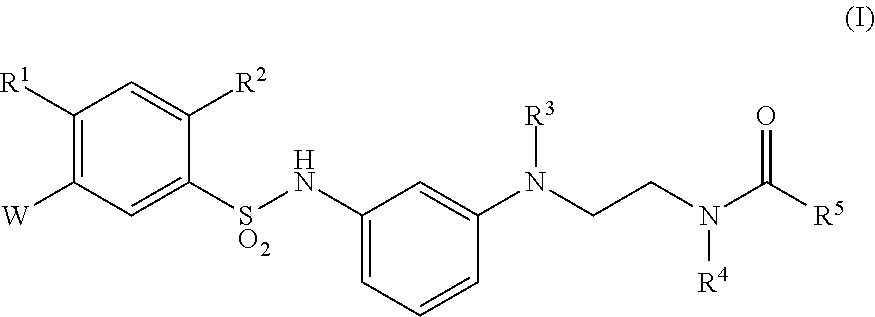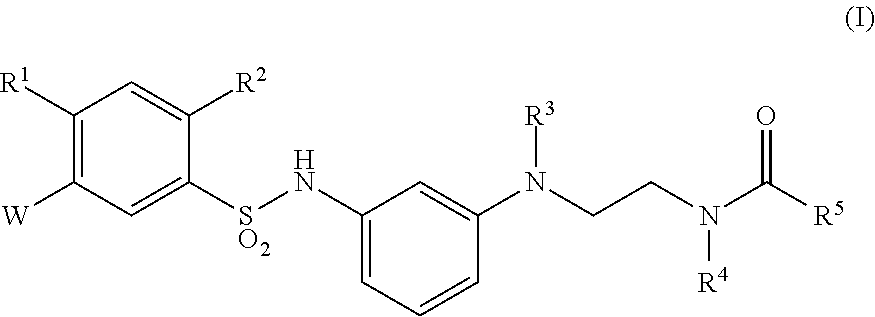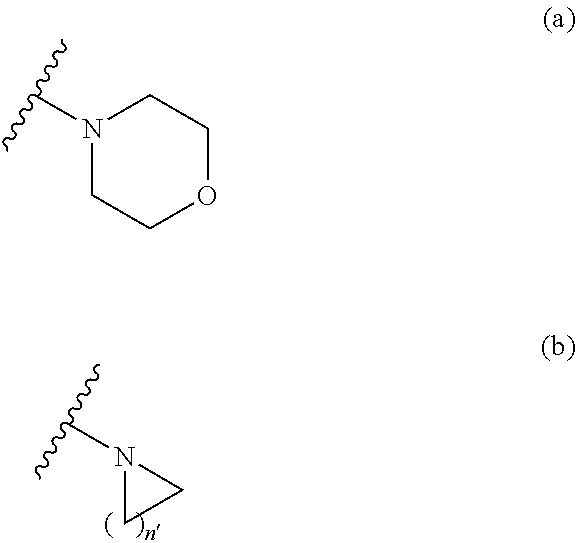Sulfonamide derivative or pharmaceutically acceptable acid addition salt thereof
a sulfonamide and acid addition technology, applied in the field of new drugs, can solve the problems of not basic treatment methods, orexins are peptides, and are not useful for pharmaceutical use, and achieve the effect of superior ox2r agonist activity
- Summary
- Abstract
- Description
- Claims
- Application Information
AI Technical Summary
Benefits of technology
Problems solved by technology
Method used
Image
Examples
reference example 1
tert-butyl (2-((3-nitrophenyl)amino)ethyl)carbamate
[0113]
[0114]Under an argon atmosphere, to 3-fluoronitrobenzene (3.21 mL) was added ethylenediamine (25.0 mL), and the mixture was stirred at 100° C. for 24 hr. To this reaction mixture was added saturated aqueous sodium hydrogen carbonate solution, and the mixture was extracted with chloroform. The organic layer was dried over sodium sulfate, filtered, and the filtrate was concentrated. To a solution of the obtained residue in dichloromethane (50 mL) were added triethylamine (4.60 mL), di-tert-butyl dicarbonate (6.55 g), and the mixture was stirred at room temperature for 2 hr. To this reaction mixture was added saturated aqueous sodium hydrogen carbonate solution, and the mixture was extracted with chloroform. The organic layer was dried over sodium sulfate, filtered, and the filtrate was concentrated. The obtained residue was purified by silica gel column chromatography (eluate: ethyl acetate / hexane=1 / 4→1 / 3) to give tert-butyl (2-...
reference example 2
tert-butyl (2-((3-aminophenyl)(benzyl)amino)ethyl)carbamate
[0115]
(1) Under an argon atmosphere, to a solution of tert-butyl (2-((3-nitrophenyl)amino)ethyl)carbamate (4.46 g) in dichloromethane (30 mL) were added 50 wt % aqueous sodium hydroxide solution (10 mL), benzyl bromide (2.84 mL) and tetrabutylammoniumiodide (587 mg), and the mixture was stirred at 20-30° C. for 48 hr. To this reaction mixture was added saturated aqueous sodium hydrogen carbonate solution, and the mixture was extracted with chloroform. The organic layer was dried over sodium sulfate, filtered, and the filtrate was concentrated. The obtained residue was purified by silica gel column chromatography (eluate: ethyl acetate / hexane=1 / 6→1 / 4) to give tert-butyl (2-(benzyl(3-nitrophenyl)amino)ethyl)carbamate (4.62 g).
(2) Under an argon atmosphere, to a mixed suspension of tert-butyl (2-(benzyl(3-nitrophenyl)amino)ethyl)carbamate in ethanol (50 mL) and water (20 mL) were added ammonium chloride (6.69 g) and iron powder...
reference example 3
tert-butyl (2-((3-aminophenyl)(4-methoxybenzyl)amino)ethyl)carbamate
[0116]
(1) Under an argon atmosphere, to a solution of tert-butyl (2-((3-nitrophenyl)amino)ethyl)carbamate (4.46 g) in DMF (30 mL) were added potassium carbonate (1.21 g), sodium iodide (1.01 g) and 4-methoxybenzylchloride (1.00 mL), and the mixture was stirred at 60° C. overnight. To this reaction mixture was added saturated brine, and the mixture was extracted with ethyl acetate. The organic layer was washed with water, dried over sodium sulfate, filtered, and the filtrate was concentrated. The obtained residue was purified by silica gel column chromatography (eluate: ethyl acetate / hexane=1 / 3→1 / 2→1 / 1) to give tert-butyl (2-(4-methoxybenzyl(3-nitrophenyl)amino)ethyl)carbamate (2.78 g).
(2) To a solution of tert-butyl (2-(4-methoxybenzyl(3-nitrophenyl)amino)ethyl)carbamate (1.13 g) in methanol (20 mL) was added 10% palladium / carbon (339 mg), and the mixture was stirred under a hydrogen atmosphere at room temperature f...
PUM
| Property | Measurement | Unit |
|---|---|---|
| reaction temperature | aaaaa | aaaaa |
| reaction temperature | aaaaa | aaaaa |
| reaction temperature | aaaaa | aaaaa |
Abstract
Description
Claims
Application Information
 Login to View More
Login to View More - R&D
- Intellectual Property
- Life Sciences
- Materials
- Tech Scout
- Unparalleled Data Quality
- Higher Quality Content
- 60% Fewer Hallucinations
Browse by: Latest US Patents, China's latest patents, Technical Efficacy Thesaurus, Application Domain, Technology Topic, Popular Technical Reports.
© 2025 PatSnap. All rights reserved.Legal|Privacy policy|Modern Slavery Act Transparency Statement|Sitemap|About US| Contact US: help@patsnap.com



